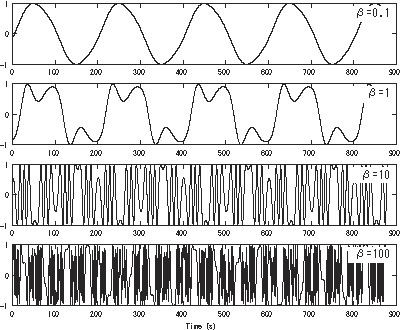 | ||
In audio and music, frequency modulation synthesis (or FM synthesis) is a form of audio synthesis where the timbre of a simple waveform (such as a square, triangle, or sawtooth) is changed by modulating its frequency with a modulator frequency that is also in the audio range, resulting in a more complex waveform and a different-sounding tone that can also be described as "gritty" if it is a thick and dark timbre. The frequency of an oscillator is altered or distorted, "in accordance with the amplitude of a modulating signal." (Dodge & Jerse 1997, p. 115)
Contents
FM synthesis can create both harmonic and inharmonic sounds. For synthesizing harmonic sounds, the modulating signal must have a harmonic relationship to the original carrier signal. As the amount of frequency modulation increases, the sound grows progressively more complex. Through the use of modulators with frequencies that are non-integer multiples of the carrier signal (i.e. non-harmonic), atonal and tonal bell-like and percussive sounds can easily be created.
FM synthesis using analog oscillators may result in pitch instability. However, FM synthesis can also be implemented digitally, the latter proving to be more 'reliable' and is currently seen as standard practice. Digital FM synthesis (using the more frequency-stable phase modulation variant) was the basis of several commercial musical instruments beginning as early as 1977. The Synclavier I, manufactured by New England Digital Corporation beginning in 1977, included a 32-voice digital FM synthesizer. Yamaha's groundbreaking DX7 brought FM to the forefront of synthesis in the mid-1980s.
History
The technique of the digital implementation of frequency modulation, which was developed by John Chowning (Chowning 1973, cited in Dodge & Jerse 1997, p. 115) at Stanford University in 1967-68, was patented in 1975 and later licensed to Yamaha. It was initially designed for radios to transmit voice by modulating one waveform's frequency with another's. This is why FM radio is called FM (frequency modulation).
The implementation commercialized by Yamaha (US Patent 4018121 Apr 1977 or U.S. Patent 4,018,121) is actually based on phase modulation, but the results end up being equivalent mathematically as both are essentially a special case of QAM, with phase modulation simply making the implementation resilient against undesirable drift in frequency of carrier waves due to self-modulation or due to DC bias in the modulating wave.
As noted earlier, FM synthesis was the basis of some of the early generations of digital synthesizers, most notably those from New England Digital Corporation and Yamaha. Yamaha's popular DX7 synthesizer was ubiquitous throughout the 1980s. Several other models by Yamaha provided variations and evolutions of FM synthesis during that decade.
Yamaha had patented its hardware implementation of FM in the 1980s, allowing it and New England Digital Corporation (under license from Yamaha) to nearly monopolize the market for that technology until the mid-1990s. Casio developed a related form of synthesis called phase distortion synthesis, used in its CZ range of synthesizers. It had a similar (but slightly differently derived) sound quality to the DX series. Don Buchla implemented FM on his instruments in the mid-1960s, prior to Yamaha's patent. His 158, 258 and 259 dual oscillator modules had a specific FM control voltage input, and the model 208 (Music Easel) had a modulation oscillator hard-wired to allow FM as well as AM of the primary oscillator. These early applications used analog oscillators, and this capability was also followed by other modular synthesizers and portable synthesizers including Minimoog and ARP Odyssey.
With the expiration of the Stanford University FM patent in 1995, digital FM synthesis can now be implemented freely by other manufacturers. The FM synthesis patent brought Stanford $20 million before it expired, making it (in 1994) "the second most lucrative licensing agreement in Stanford's history". FM today is mostly found in software-based synths such as FM8 by Native Instruments or Sytrus by Image-Line, but it has also been incorporated into the synthesis repertoire of some modern digital synthesizers, usually coexisting as an option alongside other methods of synthesis such as subtractive, sample-based synthesis, additive synthesis, and other techniques. The degree of complexity of the FM in such hardware synths may vary from simple 2-operator FM, to the highly flexible 6-operator engines of the Korg Kronos and Alesis Fusion, to creation of FM in extensively modular engines such as those in the latest synthesisers by Kurzweil Music Systems.
New hardware synths specifically marketed for their FM capabilities disappeared from the market after the release of the Yamaha SY99 and FS1R, and even those marketed their highly powerful FM abilities as counterparts to sample-based synthesis and formant synthesis respectively. However, well-developed FM synthesis options are a feature of Nord Lead synths manufactured by Clavia, the Alesis Fusion range, the Korg Oasys and Kronos and the Modor NF-1. Various other synthesizers offer limited FM abilities to supplement their main engines.
Most recently, in 2016, Korg released the Korg Volca FM, an FM iteration of the Korg Volca series of compact, affordable desktop modules.
Spectral analysis
The spectrum generated by FM synthesis with one modulator is expressed as follows:
For modulation signal
If we were to ignore the constant phase terms on the carrier
where
